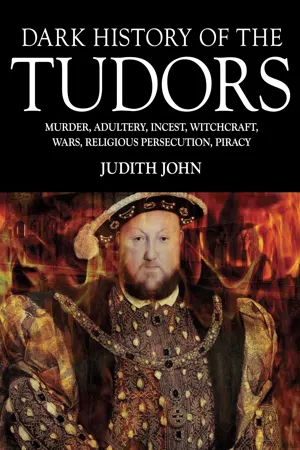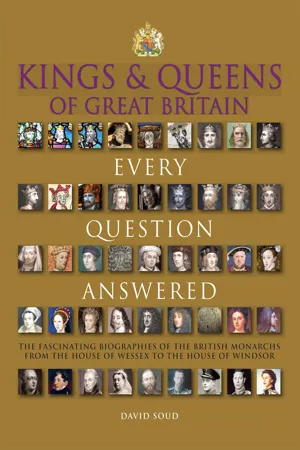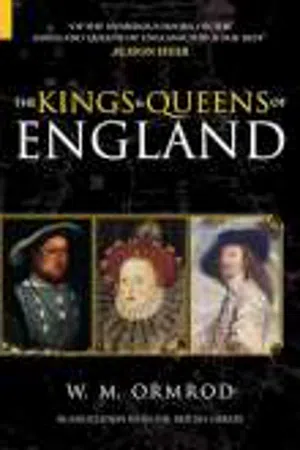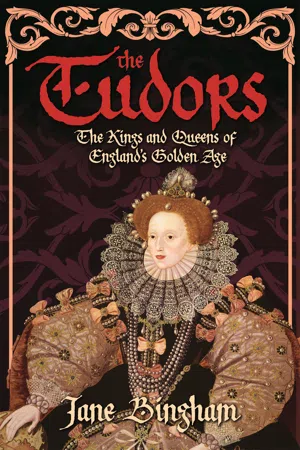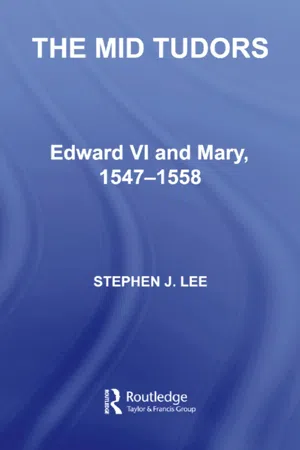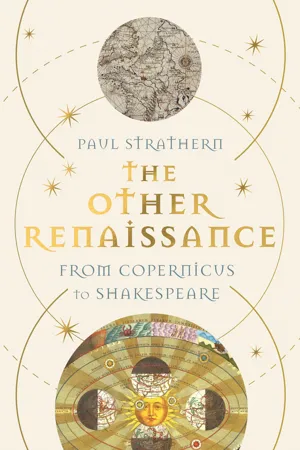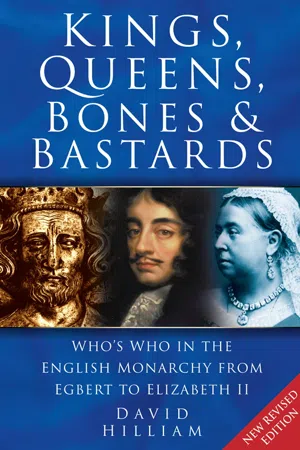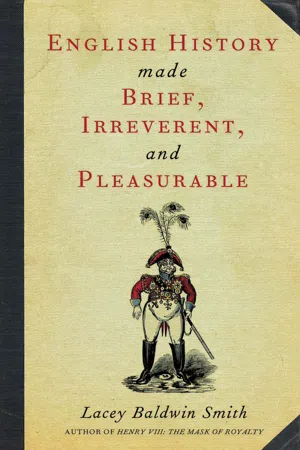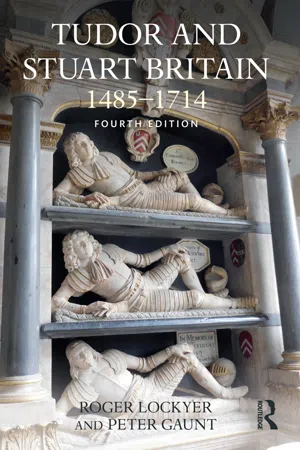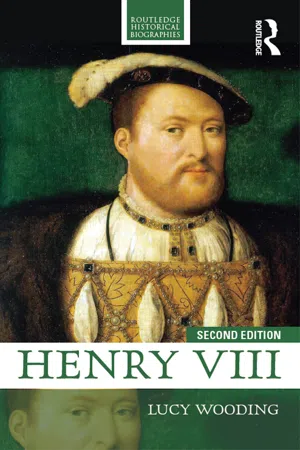History
Henry VII
Henry VII was the first Tudor monarch of England, reigning from 1485 to 1509. He established the Tudor dynasty after defeating Richard III at the Battle of Bosworth Field. Known for his financial reforms and establishment of a strong monarchy, Henry VII's reign marked the end of the Wars of the Roses and the beginning of a period of relative stability in England.
Written by Perlego with AI-assistance
Related key terms
11 Key excerpts on "Henry VII"
- eBook - ePub
Dark History of the Tudors
Murder, adultery, incest, witchcraft, wars, religious persecution, piracy
- Judith John(Author)
- 2014(Publication Date)
- Amber Books Ltd(Publisher)
This picture shows King Henry VII, lavishly robed and holding a Tudor rose. Note the combination of the white rose of York and the red rose of Lancaster, united under the Tudor King.I
TUDORS
Henry VII: ORIGINS OF A DYNASTY
The Tudor era lasted from 1485 to 1603. Compared to the House of Plantagenet (1154 to 1485), this was not long, yet the Tudor period is packed with some of the most famous and infamous British monarchs. Their legacy lives on in many dark and disreputable stories, including murder, execution, treason, false imprisonment, womanizing, illegitimate children, religious turmoil and the burning of heretics.The turbulent reign of the first Tudor King, Henry VII, begins.H enry VII’s ascent to the throne in 1485 was by no means secure. At the time of his coronation there were more than ten others with a greater claim than him, including his own mother, Margaret Beaufort. A direct descendant of John of Gaunt, Margaret was his great-granddaughter. However, a combination of circumstances, political manipulation and personal belief in himself as the rightful King would mean that Henry of Richmond would become Henry VII, the first Tudor King, who successfully ended the War of the Roses and united the houses of York and Lancaster. But his reign, and that of his ancestors, was by no means peaceful. Henry would live in constant fear of someone coming along to usurp his hard-won crown.Edward IV’s portrait shows a healthy, happy man. Yet Edward died suddenly at the age of forty-one of an unconfirmed illness. Many believe his appetites and excesses in life led to his untimely death, which triggered a resurgence in the fight for the crown.Growing Up in Exile
As Henry was a potential rival to the Yorkist monarchy – first to Edward IV, then Richard III – he was sent away from home for his own safety as a child. By the time Henry reached the age of 14 in 1471, his father, the weak-willed Edmund Tudor, had died and the continuing Wars of the Roses made life in Britain too dangerous for a potential claimant to the English throne, so Henry was taken to Brittany by his mother and uncle, Jasper Tudor. Brittany was a separate, independent duchy, governed by Francis II and was at that time not considered part of France (even though the current French King, Louis XI, desperately wanted to claim it as part of his kingdom). This meant that Henry was relatively safe from attempts by both Edward IV, then Richard III, to coax Louis XI into sending Henry back to England, where it was likely that the threat he presented to the King would have resulted in his imprisonment or even execution. - eBook - ePub
Kings & Queens of Great Britain
Every Question Answered
- David Soud(Author)
- 2014(Publication Date)
- Thunder Bay Press(Publisher)
The House of TudorAfter the Wars of the Roses had effectively culled the nobility of England, Henry Tudor was there to pick up the pieces, and he founded the dynasty that brought England into the modern era. Though it only lasted a little over a century, the Tudor dynasty transformed England completely. Henry VIII, brilliant as he was brash, made England a Protestant nation; his daughter Elizabeth I would keep it so, however ruthlessly, and in the process guide the nation through several dangerous decades to secure its place as a major European power. Under the Tudors, British culture blossomed spectacularly. It was the age of William Shakespeare and Francis Bacon. Here was Britain’s Renaissance.Henry VII Remaker of the Monarchy
H enry VII was an unlikely founder of England’s most storied dynasty, but he proved a capable and forward-thinking monarch. In the wake of the Wars of the Roses, he fended off multiple challenges to his rule and left his heirs a legacy of shrewd diplomacy, tight-fisted control of the nobility, and enormous royal wealth.House TudorBorn January 28, 1457Died April 21, 1509Reigned 1485–1509Consort Elizabeth of York (died 1503);Children Eight, including Henry VIIISuccessor Henry VIIIIN GOVERNMENT HE WAS SHREWD AND PRUDENT, SO THAT NO ONE DARED TO GET THE BETTER OF HIM THROUGH DECEIT OR GUILEMargaret of York, known after marriage as Margaret of Burgundy. The sister of Edward IV and Richard III, she was an implacable enemy of Henry VII, supporting the bids of both Lambert Simnel and Perkin Warbeck to usurp the English throne.POLYDORE VERGILWhen Richard III was unhorsed and slain at Bosworth, his adversary, Henry Tudor, found himself the last man standing in the Wars of the Roses. His unlikely bid for the throne had been engineered by two queens who had once been enemies in that conflict: his mother, Margaret Beaufort, of the Lancastrian faction, and Elizabeth Woodville, widow of Edward IV of the House of York. When, in January 1486, Henry married Elizabeth of York, daughter of Edward IV, the red and white roses of Lancaster and York merged into the Tudor rose, a symbol of reconciliation and new beginnings. - eBook - ePub
- W M Ormrod, The British Library(Authors)
- 2011(Publication Date)
- The History Press(Publisher)
T he argument that the Tudors brought peace, stability and prosperity to England after a century of infighting and disorder is a myth very largely of their own making: Henry VII, Henry VIII and Elizabeth I were all expert in the arts of what today is called propaganda, and much of the popular modern image of those rulers still derives from the messages they chose to impart to their subjects. To an extent, the Tudors were simply the beneficiaries of an economic and cultural dispensation that gave England new wealth, new ideas, and a new sense of its own identity during the sixteenth century. On the other hand, the greatest of the Tudors, Henry VIII and Elizabeth I, clearly helped to shape the government, religion and culture of their realm in a forceful, dynamic and expansive manner that demonstrated not only the long stretch of the arm of State but the real and considerable impact of personal monarchy. Most remarkably – and something often taken too much for granted today – the Tudor dynasty was the first successfully to establish both the principle and the practice of female monarchy: and if the experiment manifestly failed in the case of Jane Grey, and was at best of arguable success in the case of Mary I, it was spectacularly vindicated by the exceptionally durable and stable reign of Elizabeth I. Without the right of female succession, the Tudor dynasty would have failed in 1553, and might have gone down in history more in terms of the Lancastrian regime which, to a degree, it had earlier claimed to reinstate. The triumph of pragmatism represented in the failure of the male succession and the acceptance of regnant queens in itself articulated something of the new political culture that the Tudors had embraced and imposed upon the kingdom of England.Henry VII (1485-1509)
Henry VII was born at some distance from the English throne. His mother, Margaret Beaufort, was the great-granddaughter of John of Gaunt by his mistress, Katherine Swynford, and it was from her that Henry derived the dregs of Plantagenet blood that were his claim to the succession in 1485. His father, Edmund Tudor, was connected less directly but more respectably with royalty. He was the son of a Welsh gentleman, Owen Tudor, a minor officeholder in the Lancastrian court who won the hand in marriage of none other than Catherine of Valois, the young widow of Henry V. Henry VII made more of this connection than he did of his dubious descent from John of Gaunt: Henry V was still a charismatic enough figure to be worth invoking, even if only as a relative by marriage. The irony is that, were it not for the French Salic Law (which, though not recognized by the English, forbade female succession), Henry VII had a better claim to the French crown than to the English.Henry was born on 28 January 1457, a few months after his father’s death and a little before his mother’s fourteenth birthday. His early years were overshadowed by the Wars of the Roses, and once Prince Edward of Lancaster (the only son of Henry VI) fell in the Battle of Tewkesbury (1471), Henry was packed off abroad for safety. As Edward IV consolidated his position in the 1470s, Henry’s prospects seemed bleak. Edward had two sons and two brothers, and the nobility of England rallied behind him. Had it not been for Richard III, Henry could never have become king. It was Richard who cleared his path, splitting the Yorkist interest by calling the legitimacy of his two nephews into question, seizing the throne from them, and having them murdered. - eBook - ePub
Early Modern England 1485-1714
A Narrative History
- Robert Bucholz, Newton Key(Authors)
- 2019(Publication Date)
- Wiley-Blackwell(Publisher)
CHAPTER ONEEstablishing the Henrician Regime, 1485–1525On 22 August 1485 rebel forces led by Henry Tudor, earl of Richmond (1457–1509), defeated a royal army under King Richard III (1452–85; reigned 1483–5) at the battle of Bosworth Field, Leicestershire (see Map 1.1 ). As all students of Shakespeare know, Richard was killed. His crown, said to have rolled under a hawthorn bush, was retrieved and offered to his opponent, who wasted no time in proclaiming himself King Henry VII. According to tradition, these dramatic events ended decades of political instability and established the Tudor dynasty, which would rule England effectively for over a century.As told in Shakespeare's Tragedy of King Richard III, Henry's victory and the rise of the Tudors has an air of inevitability. But Shakespeare wrote a century after these events, during the reign of Henry's granddaughter, Queen Elizabeth (1533–1603; reigned 1558–1603). Naturally, his hindsight was 20/20 and calculated to flatter the ruling house under which he lived. No one alive in 1485, not even Henry, could have felt so certain about his family's prospects. During the previous hundred years three different royal houses had ruled England. Each had claimed a disputed succession and each had fallen with the murder of its king and head. Each line had numerous descendants still living in 1485, some of whom had better claims to the throne than Henry did. Recent history suggested that each of these rival claimants would find support among the nobility, so why should anyone bet on the Tudors to last? There was little reason to think that the bloodshed and turbulence were over.And yet, Henry VII would not be overthrown. Despite many challenges he would rule England for nearly 25 years and die in his bed, safe in the knowledge that his son, the eighth Henry, would succeed to a more or less united, loyal, and peaceful realm supported by a full treasury. The story of how Henry VII met these challenges and established his dynasty will be told in this chapter. But first, in order to understand the magnitude of the task and its accomplishment, it is necessary to review briefly the dynastic crisis known, romantically but inaccurately, as the Wars of the Roses.1 - eBook - ePub
The Tudors
The Kings and Queens of England's Golden Age
- Jane Bingham(Author)
- 2017(Publication Date)
- Arcturus(Publisher)
Chapter 2
A Dynasty is Born – the Reign of Henry VII
For the young Henry VII, the Battle of Bosworth Field was just the beginning. At the age of 28, he faced the daunting task of hanging on to the throne and passing it on to his heirs – something that every English king since Henry V had failed to do. In a land of which he knew little, surrounded by enemies, he was expected to bring peace and stability. Thirty years of civil war had delivered a dangerous degree of power into the hands of the English barons. The royal coffers were empty, and England’s reputation among its foreign rivals stood perilously low. The kingdom was in desperate need of healing and the English people looked to their new king to perform the miracle.Securing the Throne
At first sight, there was little in Henry’s background to prepare him for his role as king. Separated from his mother at the age of four, he had been brought up in exile in Wales and France without a father to guide him. When he was just 12 years old, he had lost a trusted guardian (in the person of Lord Herbert) and he had been compelled to spend his early manhood in enforced idleness in the Breton court. While all the English nobles were accustomed to ruling great estates, Henry Tudor had never even run a small manor. Of his 28 years, less than two had been spent on English soil and he had no real power base in his new kingdom.Yet despite all his evident disadvantages, Henry’s troubled youth had furnished him with several useful qualities. From an early age, he had observed the power games played by others, acquiring an intimate understanding of the dangerous world of politics. Outside his small circle of trusted friends and advisers, Henry had learned not to rely on the judgements of others. Instead, he had grown accustomed to judging characters and situations for himself, only taking action after careful consideration. Above all, Henry’s years of insecurity had left him with an overwhelming desire for stability – a longing that would lead to his establishment of a secure and well-funded monarchy. - eBook - ePub
The Mid Tudors
Edward VI and Mary, 1547–1558
- Stephen J. Lee(Author)
- 2006(Publication Date)
- Routledge(Publisher)
Henry VIII’s legacy was therefore a mixed one. On the one hand, England seemed to be pointed firmly in the direction of enmity with France and, where possible, alliance with Spain and the Emperor. On the other, there were possibilities for reconciliation with France, involving England changing sides in the Habsburg–Valois conflict. This absence of any irrevocable commitment was to continue through the middle decades of the sixteenth century. The reign of Edward VI (1547–53) was to see the continuation of both trends (pages 81–2). Somerset sided with the Emperor against France which, of course, reacted by stirring up the Scottish threat. Then, after his rise to power in 1549, Northumberland reversed the process by signing the Treaty of Boulogne with France in 1550, before attempting – unsuccessfully – to make England the broker between France and the Habsburgs. Mary (1553–58) made it her priority to develop Spanish amity and her marriage with Philip II of Spain seemed to secure this (page 82); certainly her reign saw renewed and intensified conflict with France, culminating in England’s loss of Calais in 1558 (page 83). France continued to be seen as the main threat in the opening years of Elizabeth’s reign, only for a complete reversal to occur in the 1570s. The main reason for this was the sudden descent of France into civil war and the emergence of Spain as the major power of western Europe. Elizabeth’s England, unlike that of Henry VIII, was to re-emerge as that power’s main challenger. By no stretch of the imagination, however, could this be accredited to Henry VIII’s policies.Questions
- What was Henry VIII’s achievement?
- How much of this achievement survived his death in 1547?
ANALYSIS 2: HOW HAVE HISTORIANS INTERPRETED THE HENRICIAN ‘REVOLUTIONS’ AND THEIR SUBSEQUENT IMPACT?
Ever since the early 1950s some historians have argued that Henry VIII’s reign was nothing less than ‘revolutionary’ in its impact, both at the time and in the future. Some, like G.R. Elton, saw the establishment of ‘the sovereignty of the king in parliament’ as a ‘revolution in government’,2 while others, like A.G. Dickens, focused on the religious transformation, or the Reformation as a revolution.A ‘revolution in government’?
According to Elton, Henry VIII’s reign played a crucial role in the country’s political development: indeed, the 1530s brought one of the ‘three administrative revolutions’ in English history.3 The first had been ‘The Anglo-Norman creation of a centralised feudal state governed by the king in his household’,4 which had remained essentially unchanged throughout the Middle Ages and was merely refined by the Yorkists, Henry VII and Wolsey. The second was the reforms of the 1530s which involved an altogether new principle of ‘an administration relying on the household’ being replaced by ‘one based exclusively on bureaucratic departments and officers of state’.5 The result was the introduction of a more formal system for the control of finances in a number of ‘parallel revenue courts’,6 including the Court of First Fruits and Tenths and the Court of Augmentations, established to handle the revenue coming in from the church as a direct result of the Reformation. This was accompanied by the emergence of a smaller and more cohesive central structure, ‘a formal government board, the privy council’,7 and the greatly enhanced status of the office of principal secretary. This situation continued, with further modifications, until the nineteenth century, when a third administrative revolution ended the remnants of the ‘medieval system’ and ‘created an administration based on departments responsible to parliament’.8 - eBook - ePub
The Other Renaissance
From Copernicus to Shakespeare
- Paul Strathern(Author)
- 2023(Publication Date)
- Atlantic Books(Publisher)
CHAPTER 7
THE RISE OF ENGLAND
E NGLAND’S INVOLVEMENT IN THIS potentially explosive situation would prove both symptomatic and unique. Such a paradoxical role can in large part be ascribed to the country’s insular nature and the character of its rulers during this period. England may not have been central to the birth of the northern Renaissance, as Florence was to the birth of the Italian Renaissance, but its drastic transformation would be echoed by similarly drastic changes in countries from France to Spain, the Netherlands to Bohemia. For this reason it is worth outlining England’s situation in a little more detail.The foundation of England’s role in the Other Renaissance was laid by Henry VII, who became king by defeating Richard III at the Battle of Bosworth Field in 1485. This put an end to the civil war known as the Wars of the Roses, which had dragged on intermittently for the previous quarter of a century. Henry VII was leader of the Red Rose House of Lancaster, and united the country by marrying Elizabeth of York, of the White Rose House of York. Henry VII thus established the House of Tudor as a royal dynasty. Having ascended the throne at thirty-eight, he would reign for twenty-four years, during which the ravaged medieval land was transformed into a country capable of playing a vital role in the northern Renaissance.Henry VII put England on a firm economic footing by promoting the cross-Channel wool trade with the Netherlands, from whence this product was transported to such cities as Florence in northern Italy. Here the raw fleece was transformed into fine cloth. It was this trade, financed by the Medici Bank of Florence, which provided the financial stimulus for the Italian Renaissance.Henry VII may have introduced a period of comparative peace and prosperity, but the English nobility would pay heavily for this in the form of the king’s extensive and avaricious tax policy. This was administered by his chancellor, Archbishop Morton, with his notorious ‘Morton’s Fork’, an early catch-22. Parsimonious noblemen who spent little were deemed to be saving much, and were taxed accordingly; whereas those who spent their money more freely evidently had enough to pay higher taxes… They couldn’t win. Much of this income found its way into the royal coffers, and Henry VII’s seventeenth-century biographer Francis Bacon would go so far as to claim that Henry VII was diligent about keeping detailed records of his personal finance down to the last half-penny. Records show that he also personally initialled every single page of the National Exchequer account ledgers. - eBook - ePub
Kings, Queens, Bones and Bastards
Who's Who in the English Monarchy From Egbert to Elizabeth II
- David Hilliam(Author)
- 2011(Publication Date)
- The History Press(Publisher)
Perhaps Henry’s master-stroke was his marriage to Edward IV’s daughter, Elizabeth of York. As far back as 1483, even before Bosworth and while he was still in exile, Henry had taken a solemn oath, on Christmas Day, in Rennes Cathedral that when he became King of England he would marry the Princess Elizabeth, heiress of the House of York. On the face of it, this union looks like a cool premeditated marriage of convenience, and certainly it did serve, very successfully, to unite the warring factions of York and Lancaster. The red and white ‘Tudor Rose’ was a logo which everybody could understand: unity at last.However, Henry and Elizabeth became a devoted couple. Almost uniquely among English kings, Henry was totally faithful to his young wife, ten years his junior. Together they took immense pride in their growing family. Henry made special arrangements for Elizabeth to give birth to her first child at Winchester. It was a boy, and the nation rejoiced as they christened him Arthur, a name which recaptured the past legendary glory of Britain.But alas, Arthur died aged fifteen, and his parents were distracted with grief. It was left for the younger boy, the future Henry VIII, to become heir and marry Arthur’s young widow, Catherine of Aragon.And then, a year later, Elizabeth herself died in childbirth. Henry was again distraught. For the rest of his life he withdrew more and more into his own private busy world of keeping England solvent.We owe much to Henry VII. He gave England peace and prosperity, which it desperately needed; he founded the remarkable Tudor dynasty; he started England off on its course of exploration and foreign trade in the newly discovered world, encouraging the Cabots in their voyages to North America.Finally, we must thank him for one of the most beautiful pieces of architecture in the world – his chapel in Westminster Abbey. Originally, he had wanted to rehabilitate his ancestor Henry VI, pressing the Pope to declare his predecessor a saint. The arrangements were never completed, but the chapel now contains his own tomb, a magnificent memorial with a life-like effigy by the Italian sculptor Torrigiano.It is a great pity that Henry VII’s other architectural masterpiece, Richmond Palace, has not survived. This was another extraordinarily beautiful building; it had fourteen turrets and a great tower. It was his favourite place of residence, and was also greatly enjoyed by Henry VIII and Elizabeth I, who eventually died there. It was built on the site of Sheen Palace, which had been destroyed by fire. Henry renamed it Richmond in reference to his own former earldom. Although the palace has gone, the name remains. - Lacey Baldwin Smith(Author)
- 2014(Publication Date)
- Academy Chicago Publishers(Publisher)
Chapter IVMORE MEMORABLE HISTORY, 1485 TO 1964
H istory used to be simpler, tidier, and far more optimistic than it is today. Nineteenth-century historians liked to credit Henry VII as the first of the so-called “New Monarchs.” His triumph over Richard III at the Battle of Bosworth Field was heralded as a good thing, for it inaugurated modern times and the end of the Middle Ages, those dreary centuries which came between the glories of Greece and Rome and the even greater glories of the modern age of capitalism, constitutionalism, professionalism, democracy and technology. Today’s historians dislike demarcating history in terms of battles and dynasties, or chopping up chronology into neat segments. They tend to see the first of the Tudors as just another medieval monarch, albeit a somewhat more efficient one, who profited from the memory of the civil wars of the roses and their political and human exhaustion, and they explain his success in reigning 24 years in terms of subterranean demographic, economic and social change which leave the reader depressed and confused.Put in its simplest terms, somewhere around 1485, the English started to have more and better sex, and though there is no firm evidence that the poor became poorer, certainly the rich became richer. The population which had been reduced by a third, possibly even by a half, during the, second half of the 14th century, finally began to respond to the new economic impulses of the 1480s and ’90s, and began an unprecedented rate of growth, rising from two to four million by 1600. Those fortunate enough to survive the bubonic plague were economically better off than ever before: more food and land to go around, fatter and healthier babies, and higher wages for all. Landowners confronted with a labor shortage turned from labor-intensive agriculture to sheep farming, where a single hired hand could watch over an entire flock. Sheep runs and a European-wide demand for English wool and broadcloth produced unprecedented prosperity—“I thank God and ever shall; it is the sheep has paid for all.” Prosperity in turn began to undermine the old medieval regulation of trade and production that had sought to protect the consumer and establish, not a market or competitive price, but a just price for all. Finally, economic competition, inflation, and social mobility generated what society feared the most: change. New names, new blood, new methods were destroying the fabric of the medieval past. In the village of Apsley Guise, each peasant in 1275 had held equal holdings of 15 acres. By 1542, four lucky and hard-working families had increased their acreage to 60 acres or more; only three still possessed their original 15 acres; and all the rest had been forced to sell out, many of them migrating to London, the boom town of the Kingdom, where the population was quadrupling, rising from 50,000 in 1500 to 200,000 a century later.- eBook - ePub
Tudor and Stuart Britain
1485-1714
- Roger Lockyer, Peter Gaunt(Authors)
- 2018(Publication Date)
- Routledge(Publisher)
From the outset of his reign, Henry VIII had projected images of himself distinctly different from those of his father. Thus he was visibly a king who was more outgoing and more obviously engaged than Henry VII, or at least than the old king had been during the closing years of his reign, and also a monarch who consciously appeared strong and martial. The feasting and socializing which marked Henry VIII’s reign from its earliest days and the tours that he took around parts of his realm most summers and early autumns were designed in part to enable the King to meet, to come to know, to entertain and be entertained by and generally to see and be seen by members of the social elite. This style was broadly maintained throughout his reign, even into his later years of declining health, though it is noticeable that the royal itineraries were very much focused on the south-eastern quarter of England and that his summer and autumn tour did not often extend much further north and west than a broad arc running from the Wash to the Solent and taking in Northamptonshire and Oxfordshire. From the outset, too, Henry was devoted to the hunt and the joust and, despite the real risks involved, he played a very prominent and distinguished part in jousting and at elaborate tournaments, until a serious accident in 1536 forced him to retire. While all this could be seen as aspects of a young king addicted to pleasure and leisure, perhaps at the price of neglecting the business of government, it is probably more accurate to interpret these activities as essential elements of Henry’s kingship and key preparation for and adjuncts to his royal government and war. Much the same could be said of another area to which Henry devoted time, energy and money, namely building, culture and the arts.On taking the throne, his father, Henry VII, had acquired a clutch of royal buildings in and around London, notably the Tower, Westminster Palace and Windsor Castle, and during his reign he had undertaken building work at all three. However, much greater attention was paid to the riverside royal palaces he developed at Richmond and Greenwich, respectively west and east of the capital, and Baynard’s Castle, also fronting the Thames in London itself. More broadly, Henry VII participated in the round of feasts, pageants and entertainments expected of a monarch and he maintained court culture, he commissioned royal portraits executed in a fairly conventional later fifteenth-century style, he may have employed some Burgundian scholars and artists in England, he collected books and built up a royal library and his reign certainly coincided with an expansion in printing. Henry’s greatest cultural legacy is probably the huge, highly decorated and exuberantly fan vaulted Lady Chapel, which he commissioned to adorn the east end of Westminster Abbey, completed and consecrated after his death; it is the burial place not only of Henry VII and his wife, who lie beneath an elaborate tomb with striking recumbent effigies, executed by the Italian sculptor Torrigiano (engaged and overseen by Henry VIII after his father’s death), but also of all the other English monarchs of the Tudor and Stuart period, excepting only Henry VIII, Charles I and James II. But, for all that, few scholars claim that Henry VII was especially interested in architectural, cultural and artistic affairs or see his connections with this area as much more than those conventionally expected of a monarch. - eBook - ePub
- Lucy Wooding(Author)
- 2015(Publication Date)
- Routledge(Publisher)
The crowns used at the coronation were believed to have belonged to Edward the Confessor and his wife, and were kept in the saint’s shrine itself. Henry was anointed and clothed in vestments like those of a bishop, indicating that as king his authority was as much sacred as temporal. The city of London was again honoured at the coronation banquet, since the king made the lord mayor a knight before he sat down, and at the end of the meal accepted hippocras – sweet spiced wine – from him in a gold cup, which cup the lord mayor was allowed to keep. This too was fully in accordance with tradition. But at the jousts which followed the coronation banquet, king and queen sat in a pavilion surmounted by ‘a great Crown Imperial’, a departure from usual practice. 18 Imperial power exceeded royal power, in particular because it claimed sovereignty over church as well as state. At this first entrance onto the political stage, then, Henry was hinting at an authority which exceeded that of his predecessors. The mental world of Tudor kingship Henry had inherited the throne, married, and been crowned, all within two months: throughout his life, he moved swiftly to secure what he wanted. In many of his actions, he was guided by the customs and precepts of established tradition, and in particular by the need to obtain and demonstrate religious sanction. Henry seems to have been a genuinely religious man, although on first sight, this seems a deeply implausible statement. After all, this was the man notorious for having six wives, and for cruelly rejecting the first, and beheading the second, both on highly specious grounds. This was the man who high-handedly reorganised the church in England, rewrote Christian doctrine, and could not even be said to have done so in the service of Protestantism, since he persecuted Catholics and Protestants alike. His religious policies were at different times a vehicle for his greed, his paranoia and his egotism
Index pages curate the most relevant extracts from our library of academic textbooks. They’ve been created using an in-house natural language model (NLM), each adding context and meaning to key research topics.
